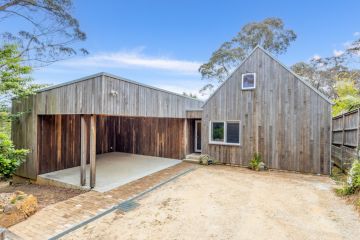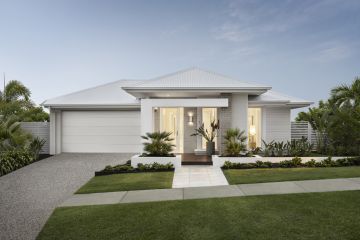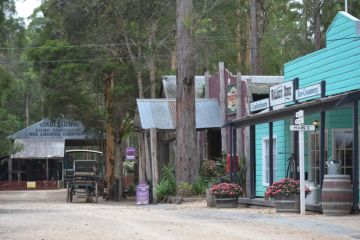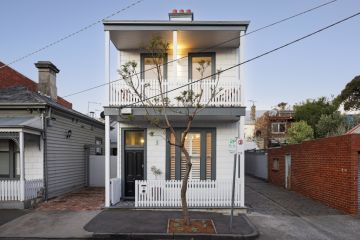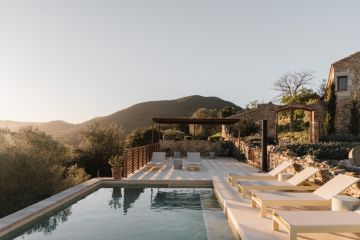‘I have an affinity for skulls’: Inside Melbourne designers’ own homes
Melbourne’s fashion designers are known for their labels’ unique style. But what happens when they pour their creativity into their homes?
We spoke to three Melbourne designers about what influences their home decor, and whether their clothing designs translate to how they live.
Kristy Barber, founder and designer of womenswear brand Kuwaii

It takes talent – and an eye for the exceptional – to furnish your home with vintage furniture and paintings picked up off the curbside.
And yet Kristy Barber, the founder-designer behind iconic Melbourne fashion brand Kuwaii, is more than adept at finding just the right thing to suit her warm, eclectic, cottage-garden Thornbury home.
“Everything I own is very similar to Kuwaii,” Barber says. “It’s all found objects, Marketplace finds, hard rubbish, things like that. That’s how I collect things that are meaningful to me.”
Much like the clothing she designs, her home is decorated in muted tones of the same colour, influenced by her time growing up in a cottage garden during the 1980s.
“It’s cottage garden colours, like leafy greens, rich, different shades of greens, and then flower colours, like mauves. It’s very nature-inspired,” Barber says.
“I’m also very attracted to pieces that have a heart pull for me … as well as checks and texture and rich fabrications. I love the tactileness of fabric, and you can definitely tell that with Kuwaii. Customers come into our shops and say, ‘Whoa, what are these fabrics?’”
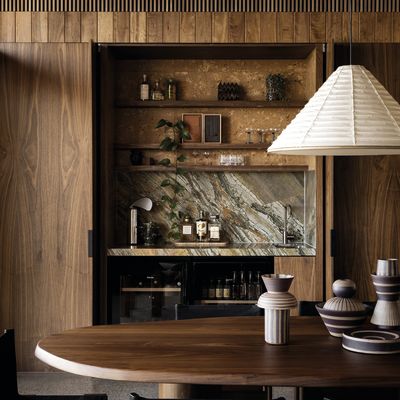 Designer insight: How home interiors are evolving in 2025
Designer insight: How home interiors are evolving in 2025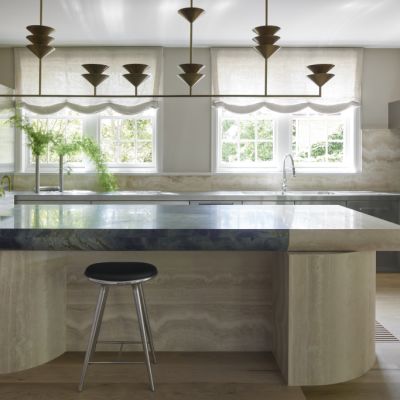 Inside Fiona Lynch studio: How fine art, natural materials and custom craft shape her interior design
Inside Fiona Lynch studio: How fine art, natural materials and custom craft shape her interior design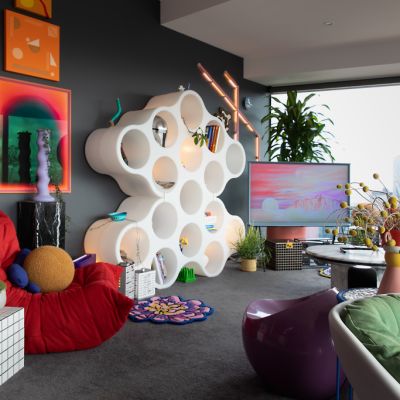 Gen Z v Millennial styling trends: How the two generations differ
Gen Z v Millennial styling trends: How the two generations differ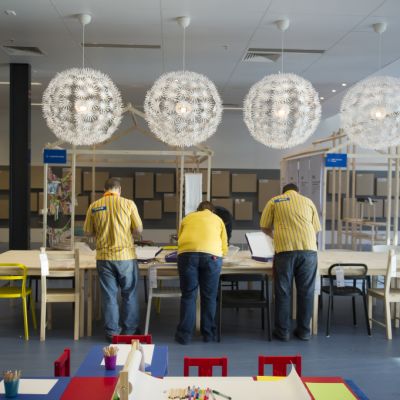 IKEA buys these interior designers love
IKEA buys these interior designers love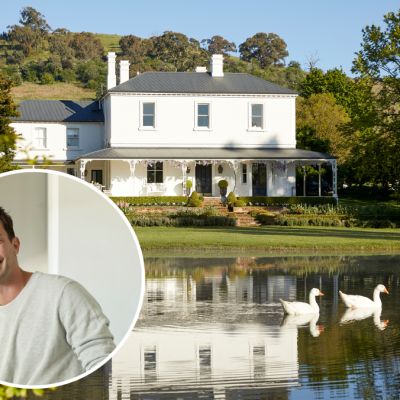 Interior designer Steve Cordony's Rosedale Farm listed for sale
Interior designer Steve Cordony's Rosedale Farm listed for sale
Her grey couch is piled with colourful, earthy-toned cushions, as she points out some of her favourite treasures.
“This is a vintage chaise, probably from the ’80s, a Marketplace find. That cabinet was from an op shop, and this painting is from an op shop in Finland,” she says, waving her hand at the green and grey toned rendition of a mountainous terrain. Barber’s husband is half Finnish, meaning they spend much of their time there, which leads to some unique finds.
Her house is dotted with other art works, some by artists she has collaborated with for Kuwaii clothing. Barber points to two ceramic cat heads, made by a friend in San Francisco, one of which is her old cat, Strudel, who has now died.
The house itself – a three-bedroom, two-bathroom, single story white weatherboard – is Barber and her husband’s first home, a 2021 post-lockdowns purchase that crystallised the importance of having a garden to Barber.
“The house was renovated about 20 years ago by a couple … and I get the feeling they were artistic types because they’ve embedded all these really interesting details, like handmade terrazzo in the bedroom, and this hand-cut crazy paving done by an artist from Castlemaine,” she says.
“There’s stained-glass around the house, and that’s what we love so much about it – it felt really special and unique. We feel like we’re the creative gatekeepers of the house.”
The garden, filled with scattered lemons and an ancient gum tree, is the true drawcard. “For the first few months when we moved in, I felt like I was living in some kind of paradise,” Barber says.
Pádraig Whelehan, founder and designer of menswear brand Brotherwolf
Unlike Barber’s muted explosion of pastels and quirky patterns, Irishman and former barber Pádraig Whelehan favours the structured lines and colours of army garb for his menswear brand, Brotherwolf.

“The aesthetic of the brand takes inspiration from the old military tailoring sportswear heritage brands, the Ivy League stuff … which I try and mesh it with some contemporary look,” Whelehan says.
While his South Yarra home carries elements of that – the sepia tones, clean lines and accents of wood – it’s a little more luxurious and less utilitarian than the clothing he designs.
“I try and keep it a bit more minimal here, because I just don’t like clutter … and too much colour can be a little overwhelming,” Whelehan says in his soft, Irish lilt. This doesn’t mean his house is monochrome: splashes of colour come through in paintings, flowers, plants and the labels of his wine bottle collection.
Where Whelehan eschews colour he inserts textures, playing with linens, brushed cottons, ceramics and steel. “These elements also go into our stores – we use a lot of wood and stone, these old, earthy materials,” he says.
Whelehan often looks to his heritage, as well as archives of old-school suiting, tailoring and vintage military wear for design inspiration.
“The last collection was one of the guys having a full Irish breakfast and a cup of tea, which felt like home. We made our take on a vintage Gaelic football jersey,” Whelehan recalls.
At home, he tries not to add something unless he really wants it. “I’ve found that in the past, you get stuff and it stays there, and it just adds to the clutter … it doesn’t have to mean anything, I just have to like it,” he says.
With six stores around Melbourne, Whelehan often recycles his home treasures between them. “I might think, ‘Oh, that would look nice in South Melbourne’ … As I collect things, I always think, ‘I’ll use it somewhere’. Nothing has to stay where it is; it can move around and have a lot of life.”
Simone Coates, creative director of Tigerlily Apparel
Looking at Simone Coates, you wouldn’t think the tall, colourfully dressed beachwear designer is obsessed with skulls.
“Here’s one from Mexico we picked up opposite the coast of the Sea of Cortez, during the flight of the stingray,” she says, pointing to a decorated animal skull hanging on her living room wall.

Her one-bedroom apartment in St Kilda includes various iterations of the cranium, including a distinctly human-shaped candle skull, in front of a glass bottle with another skull on it.
“I just have such an affinity for skulls,” she laughs, pulling up the sleeve of her orange blazer to reveal a skull tattoo. “There’s something so interesting about them.”
As head of Tigerlily – an iconic Aussie brand known for boho swimwear that’s recently been given a second chance at life after being acquired by Seafolly – Coates wouldn’t live anywhere else but bayside.
“I can’t tell you the number of storms that I’ve watched roll in,” she says. “Beautiful sunsets, beautiful sunrises … hearing the hum and clutter of people going past, hearing celebrations from the balcony … it just has a presence about it.”
While Coates also shares a home with her partner in neighbouring Albert Park, her apartment is her sanctuary, where she is free to be creative and decorate as she wants. Clashing colours and interesting textures are her MO, and when people come over, Coates says they’re often overwhelmed by her decor.
“I think probably eclectic’s the only way to describe it,” she laughs. “If you’re a minimalist, you’d come in here and go, “Oh, there’s so much going on …’. I just like … velvets, all the touchy-feely things … pieces that I found at a vintage store. It’s all really about repurposing and reinvention.”
Every corner is filled with strange and fabulous trinkets: from an Alexander McQueen skateboard, to a tiny wooden doll of former US Vogue editor Anna Wintour, to an old-school cocktail bottle gifted by her stylish mother.
”But, you know, when fashion trends come back … I’m like, ‘Oh my God, that jacket, I’ve got that jacket’, and then I’ll hunt through a cupboard or find a box and pull it out. And it’s often then when I find … little statues or things that I’ve bought that have found their way into the back of a cupboard because I haven’t got space … that I take them out again.
“[My home is] a mirror of the way I’ve lived my life and the journeys and places that I’ve been to.”
We recommend
We thought you might like
States
Capital Cities
Capital Cities - Rentals
Popular Areas
Allhomes
More
- © 2025, CoStar Group Inc.
